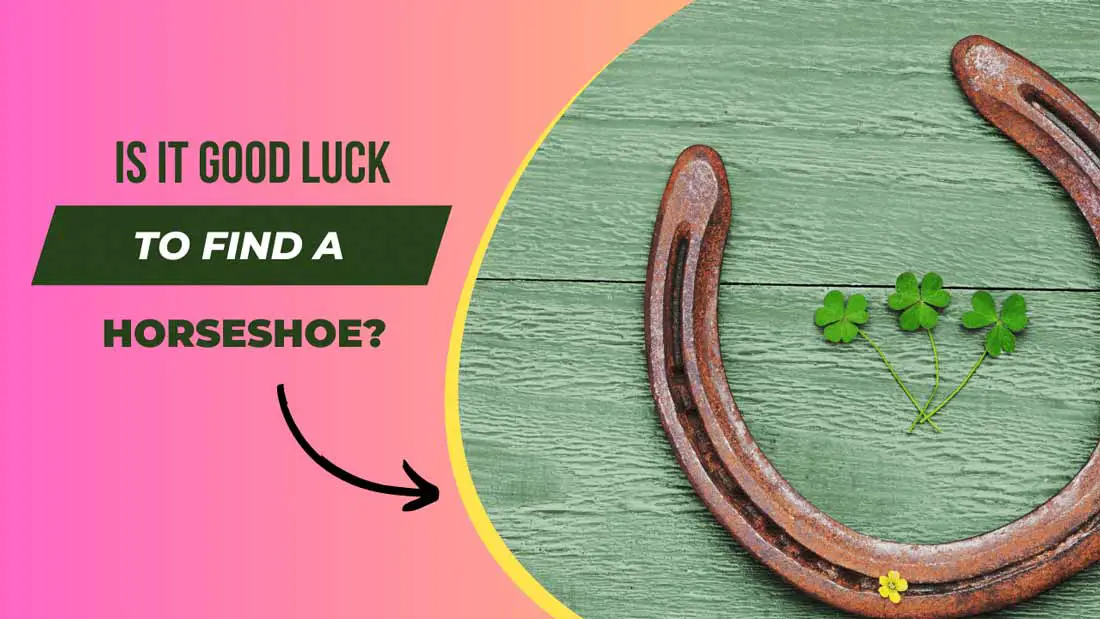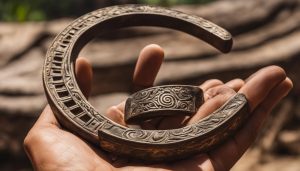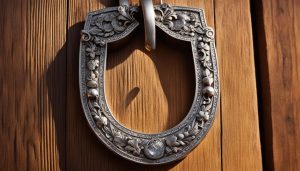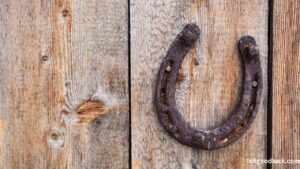Superstitions and symbols of luck have been integral to human society throughout history, influencing our behavior and beliefs in subtle yet profound ways.
Among the myriad symbols that have resonated with human cultures globally, the horseshoe occupies a significant place as an emblem of good luck and prosperity.
But what makes this everyday object an icon of fortune? Does finding a horseshoe equate to an influx of good luck?
Contents
- 1 How Horseshoes are treated in History:
- 2 How Horseshoes are used as Charms to bring good luck:
- 3 Is it Good Luck to Find a Horseshoe?
- 4 The Legacy of the Lucky Horseshoe:
- 5 Some Further Interesting Insights about Horseshoe:
- 6 FAQs:
- 6.1 Can anyone use a horseshoe for good luck, or must it be found?
- 6.2 Is there a way to hang a horseshoe for good luck?
- 6.3 Are horseshoes from different types of horses considered luckier than others?
- 6.4 What materials are considered luckiest for horseshoes?
- 6.5 Is it bad luck to refuse a horseshoe if someone offers one?
How Horseshoes are treated in History:
The horseshoe’s history as a lucky charm is deeply rooted in the lore of ancient cultures. Around the world, the horseshoe has been linked to varied divine entities and celestial bodies, infusing it with an air of magic and luck.
In ancient Greece and Rome, the horseshoe’s association with Fortuna, the goddess of fortune, positioned it as a talisman for good luck. The shape of the horseshoe, reminiscent of a crescent moon, echoed the horns of the moon goddess Selene, adding a layer of sacredness and protection to the object.
The Middle Ages carried the horseshoe superstition forward, bolstered by popular tales and folklore. One such legend features Saint Dunstan, a blacksmith turned bishop, who tricked the devil by agreeing to shoe his hoof, causing him great pain. After this encounter, the devil purportedly vowed never to enter a dwelling graced with a horseshoe, thereby framing it as a potent protector against evil.
Also read: Is it good luck to see a fox?
How Horseshoes are used as Charms to bring good luck:
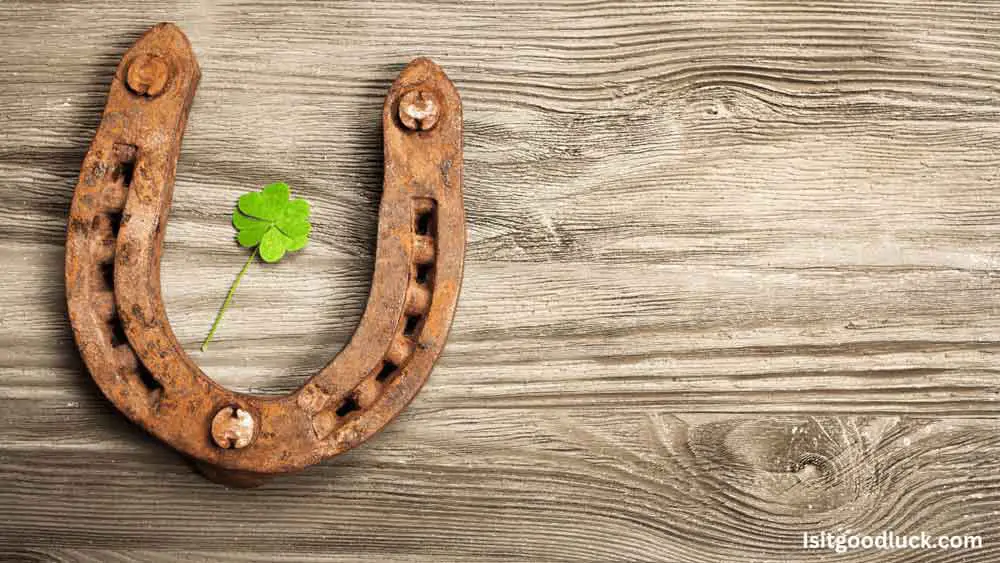
Although the mere presence of a horseshoe is believed to attract luck, how it’s utilized can impact the luck it imparts. Horseshoes often hang above doorways of homes or businesses, positioned with the open end facing upwards. Like a reservoir, this orientation is said to contain and accumulate good luck, preventing it from spilling away.
The charm of the horseshoe is not just restricted to home decor; it has found a place in personal adornments too. Horseshoe necklaces, earrings, and bracelets are constant carriers of good fortune, following the wearer wherever they go.
Interestingly, the horseshoe also takes on a protective role. Burying a horseshoe in your garden or yard can shield you against evil spirits, adding a spiritual boundary to your abode.
Is it Good Luck to Find a Horseshoe?
The circumstances surrounding the discovery of a horseshoe can play a significant role in the potency of its luck, according to various cultural beliefs.
A common belief is that a horseshoe should be found by chance, as purchased horseshoes lack the same magnetic pull to fortune. According to this lore, the ideal situation is to stumble upon a horseshoe lost by a horse, as it will carry the residual luck of the equine bearer.
Upon discovering a horseshoe, traditional practice dictates hanging it with the open end facing upwards. This orientation is a symbolic vessel to capture good luck, allowing it to spill into your life.
The Legacy of the Lucky Horseshoe:
The horseshoe’s unique position as a symbol of good luck transcends centuries, continents, and cultures. Its appeal lies in its charming folklore and romanticized superstitions and its universality as an emblem of fortune and protection.
Regardless of whether one holds a steadfast belief in the luck-bringing capabilities of the horseshoe, it serves as a tangible connection to our shared cultural histories. It’s a beautiful and unassuming symbol that carries a substantial legacy in its arc.
Finding a horseshoe can offer a spark of joy and a whisper of good luck, ready to be hung in our homes as a constant reminder of potential fortune just around the corner.
Some Further Interesting Insights about Horseshoe:
The lore surrounding horseshoes and luck extends further, creating a rich tapestry of belief and symbolism. The word “horseshoe” has Old English origins, stemming from “horseshoe.” Interestingly, Ireland is often credited as the birthplace of the tradition of hanging horseshoes for good luck.
Cultural nuances around the globe add more color to the horseshoe superstitions. For example, some cultures consider finding a horseshoe on a Friday, especially fortunate.
The number of nails in a horseshoe, too, can influence the kind of luck it brings — a horseshoe with three nails may be a lucky charm for love, while seven nails could promise wealth.
Despite the changing times, the charm of the horseshoe as a symbol of luck has remained consistent, finding expression in modern forms like jewelry, home decor, and even tattoos.
Regardless of whether you believe in its lucky potential, finding a horseshoe offers an exciting connection to a shared human heritage of belief in symbols and serendipity.
Also read other articles regarding animals good luck
FAQs:
Can anyone use a horseshoe for good luck, or must it be found?
While tradition holds that found horseshoes are the luckiest, anyone can use a horseshoe for good luck. This can be a horseshoe you’ve bought, been gifted, or even one used as an ornament or piece of jewelry. However, some people still believe in the added potency of a horseshoe found by chance.
Is there a way to hang a horseshoe for good luck?
Yes, traditionally, a horseshoe is hung with the open end facing up, creating a sort of container to ‘catch’ and hold good luck. However, some cultures believe that hanging it with the open end facing down allows good luck to flow out and cover those who walk under it.
Are horseshoes from different types of horses considered luckier than others?
There are no widely accepted beliefs that horseshoe from different types of horses carry different degrees of luck. However, some individual or localized superstitions might hold that horseshoes from certain breeds or types of horses (like racehorses or workhorses) are luckier than others.
What materials are considered luckiest for horseshoes?
Traditionally, horseshoes were made from iron, which was thought to ward off evil spirits due to their strength and durability. However, modern horseshoes can be made from various materials, including steel, aluminum, and synthetic. While iron horseshoes might hold more historical significance, there’s no definitive consensus on whether the material impacts the horseshoe’s luck.
Is it bad luck to refuse a horseshoe if someone offers one?
This varies greatly based on personal and cultural beliefs. Some might believe that refusing a horseshoe, a symbol of good luck and protection, might bring about negative consequences or miss out on a potential good fortune. However, no universally accepted beliefs or superstitions regarding refusing a gifted horseshoe exist.

